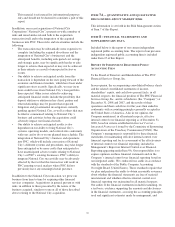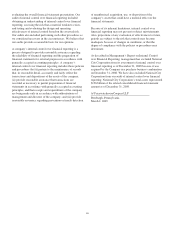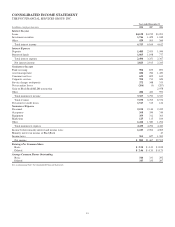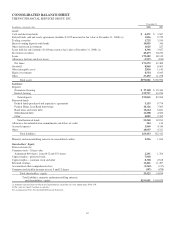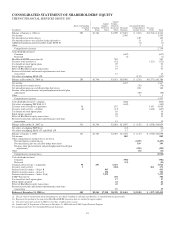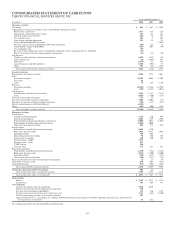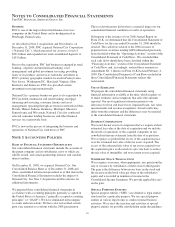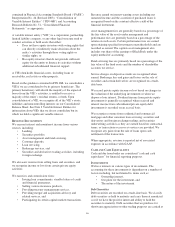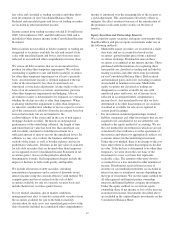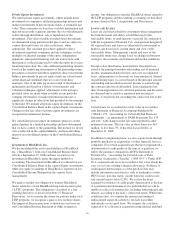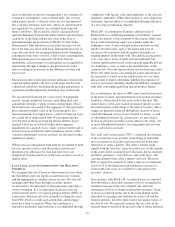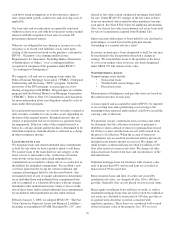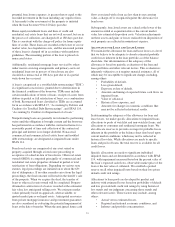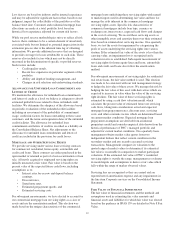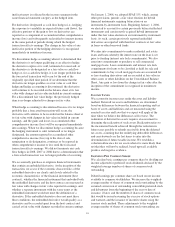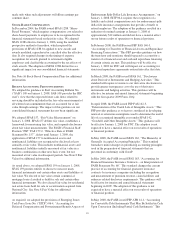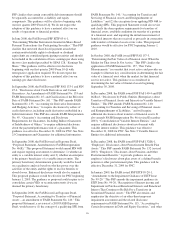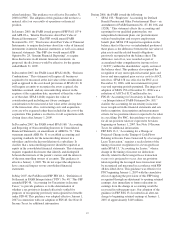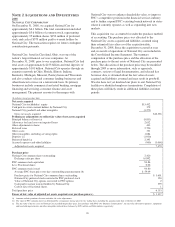PNC Bank 2008 Annual Report Download - page 92
Download and view the complete annual report
Please find page 92 of the 2008 PNC Bank annual report below. You can navigate through the pages in the report by either clicking on the pages listed below, or by using the keyword search tool below to find specific information within the annual report.Private Equity Investments
We report private equity investments, which include direct
investments in companies, affiliated partnership interests and
indirect investments in private equity funds, at estimated fair
value. These estimates are based on available information and
may not necessarily represent amounts that we will ultimately
realize through distribution, sale or liquidation of the
investments. Fair value of publicly traded direct investments
are determined using quoted market prices and are subject to
various discount factors for sales restrictions, when
appropriate. The valuation procedures applied to direct
investments in private companies include techniques such as
multiples of adjusted earnings of the entity, independent
appraisals, anticipated financing and sale transactions with
third parties, or the pricing used to value the entity in a recent
financing transaction. We value affiliated partnership interests
based on the underlying investments of the partnership using
procedures consistent with those applied to direct investments.
Indirect investments in private equity funds are valued based
on the financial statements that we receive from their
managers. Due to the time lag in our receipt of the financial
information and based on a review of investments and
valuation techniques applied, adjustments to the manager
provided value are made when available recent portfolio
company information or market information indicates a
significant change in value from that provided by the manager
of the fund. We include all private equity investments on the
Consolidated Balance Sheet in the caption Equity investments.
Changes in the fair value of private equity investments are
recognized in noninterest income.
We consolidate private equity investments when we are the
general partner in a limited partnership and have determined
that we have control of the partnership. The portion we do not
own is reflected in the caption Minority and noncontrolling
interests in consolidated entities on the Consolidated Balance
Sheet.
Investment in BlackRock, Inc.
We deconsolidated the assets and liabilities of BlackRock,
Inc. (“BlackRock”) from our Consolidated Balance Sheet
effective September 29, 2006 and now account for our
investment in BlackRock under the equity method of
accounting. The investment in BlackRock is reflected on our
Consolidated Balance Sheet in the caption Equity investments,
while our equity in earnings of BlackRock is reported on our
Consolidated Income Statement in the caption Asset
management.
We mark to market our obligation to transfer BlackRock
shares related to certain BlackRock long-term incentive plan
(“LTIP”) programs. This obligation is classified as a free
standing derivative as disclosed in Note 17 Financial
Derivatives. As we transfer the shares for payouts under such
LTIP programs, we recognize a gain or loss on those shares.
The impact of those transactions is shown on a net basis on
our Consolidated Income Statement in Other noninterest
income. Our obligation to transfer BlackRock shares related to
the LTIP programs and the resulting accounting are described
in more detail in Note 2 Acquisitions and Divestitures.
L
OANS AND
L
EASES
Loans are classified as held for investment when management
has both the intent and ability to hold the loan for the
foreseeable future, or until maturity or payoff. In conjunction
with the acquisition of National City, management designated
all acquired loans and leases as either held for investment or
held for sale based on its current intent and view of the
foreseeable future. Management’s intent and view of the
foreseeable future may change based on changes in business
strategies, the economic environment and market conditions.
Except as described below, loans held for investment are
stated at the principal amounts outstanding, net of unearned
income, unamortized deferred fees and costs on originated
loans, and premiums or discounts on loans purchased. Interest
on performing loans is accrued based on the principal amount
outstanding and recorded in interest income as earned using
the constant effective yield method. Loan origination fees,
direct loan origination costs, and loan premiums and discounts
are deferred and accreted or amortized into net interest
income, over periods not exceeding the contractual life of the
loan.
Certain loans are accounted for at fair value in accordance
with Statement of Financial Accounting Standards No.
(“SFAS”) 155, “Accounting for Certain Hybrid Financial
Instruments – an amendment of FASB Statements No. 133
and 140,” with changes in the fair value reported in other
noninterest income. The fair value of these loans was $43
million, or less than .5% of the total loan portfolio, at
December 31, 2008.
In addition to originating loans, we also acquire loans through
portfolio purchases or acquisitions of other financial services
companies. For certain acquired loans that have experienced a
deterioration of credit quality at the time of acquisition, we
follow the guidance contained in AICPA Statement of
Position 03-3, “Accounting for Certain Loans or Debt
Securities Acquired in a Transfer” (“SOP 03-3”). Under SOP
03-3, acquired loans are to be recorded at fair value absent the
carry over of any existing valuation allowances. Evidence of
credit quality deterioration as of the purchase date may
include information and statistics such as bankruptcy events,
FICO scores, past due status, current borrower credit scores,
and current loan-to-value (LTV). We review the loans
acquired for evidence of credit quality deterioration at the date
of acquisition and determine if it is probable that we will be
unable to collect all amounts due, including both principal and
interest, according to the loan’s contractual terms. When both
conditions exist, we estimate the amount and timing of
undiscounted expected cash flows for each loan either
individually or on a pool basis. We estimate the cash flows
expected to be collected at acquisition using internal and third
88



